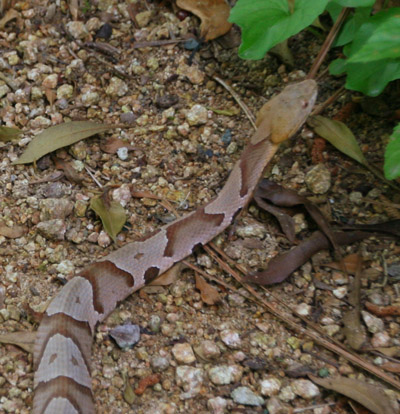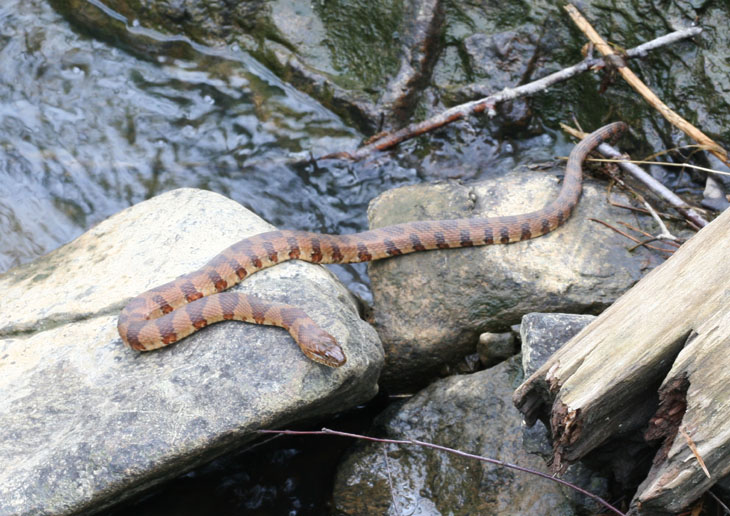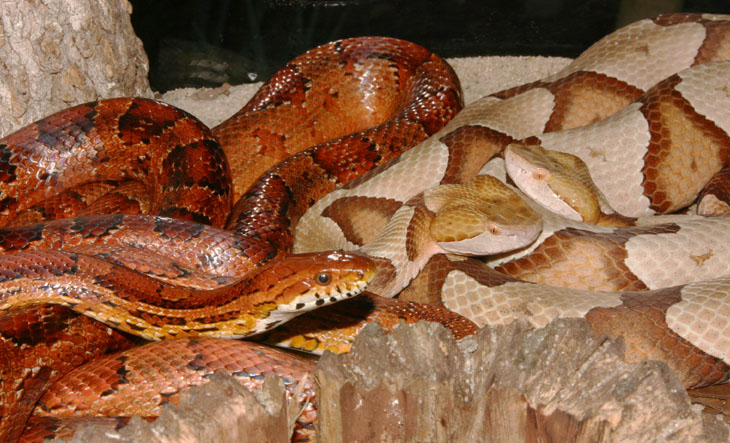Cruising through the botanical garden early yesterday morning, the very first thing I happened across was something that I’ve, honestly, never spotted in ‘the wild’ before. Which is pretty surprising to me, considering how often I specifically go out not just into prime habitats, but actually looking for snakes. You can put this down to rotten observation powers if you like; without someone else present who did spot all the snakes I missed to provide a necessary baseline, I can’t rationally argue it, but I seem to see a hell of a lot that others miss, so I personally put it down to just weird luck. This one was smack in the middle of a footpath, and its coloration made it subtle but not really camouflaged.

This is a copperhead, Agkistrodon contortrix, the only venomous snake in the area. By all accounts, there are a fair number of them around, meaning people stumble across them from time to time, but there are not so many that a serious hazard is presented. This particular one saw me at least as soon as I saw it, and instead of moving off the path (which it could do easily, into excellent protective cover,) it began giving warning displays. The first was the vibrating tail, which occurs among more than rattlesnakes, and it often presents a drumming, buzzing, or rattling sound depending on the material that it contacts – in this case it was silent. The second display is the classic and ominous one, the raising of its head from the ground and rearing back as if preparing to strike, which can be seen here – my position didn’t permit the best view of the head, and there wasn’t a lot I could (safely) do to remedy this. What concerned me was how easily someone who wasn’t paying attention could have stepped right up to the snake, which clearly wasn’t inclined to abandon its position. An awful lot of snake bites occur from people doing stupid things, and occasionally from not considering that they’re disturbing a prime habitat like brush piles, but in this case, it was clear someone could have been bitten just by not paying attention.

Now, I feel obligated to clarify a few things. Copperhead bites are rarely fatal, and the encounters few and far between; as such, they don’t really pose much of a threat, despite the reputation a lot of people want to impart to venomous snakes, and often every snake. Crossing the road is dangerous, and much more likely to result in a fatality. Playing with your stupid toy phone while driving a car is more dangerous still. We cope with these dangers by recognizing them and (usually) by avoiding doing the really stupid things, like walking out into the road without looking. And that same behavior pretty much eradicates all dangers from venomous snakes. Watch where you’re walking. Don’t leave brush piles in high-traffic areas. Don’t poke around blindly in the woods. It’s not hard.
But in a lot of cases, there is a perceived difference between dangers like cars, and venomous snakes. The snake is an example of agency; it can decide to attack you. Which is not exactly true: it decides to defend itself. While this might seem like semantics, it’s an important distinction, because the defensive behavior will only be displayed if the snake feels threatened – no snake can eat a human, nor do they have any vestige of animosity or ‘pre-emptive strikes’ or whatever (those belong solely to our own species.) To avoid snake bites, leave the snake alone. It really is that simple.
Plenty of people will tell you of truly aggressive snake attacks that they’ve heard of, which is fine if you’re inclined to believe every story you hear. The people who actually work in emergency rooms, and who catalog the reasons behind snake bites, tell a different story: most bites occur when someone initiates contact, either by attempting to ‘remove’ the snake, or by showing off in some testosterone-fueled idea of what’s necessary. I convinced the ‘aggressive’ snake here to leave the path, without even getting close to it – by stomping my feet. It felt the vibrations (they don’t have ears) and considered this a bad sign, slipping into the undergrowth out of harm’s way. That’s what the second photo is showing. And as much as I might have liked getting some better shots, I knew they weren’t worth increasing the risk (and I’ve handled more snakes than I can count, including copperheads when I worked animal rescue – that’s what that distinction of in ‘the wild’ meant up above, since all of my previous encounters were from initiated calls from the public, and not a random discovery like, seriously, 99% of my photography.)
By the way, a huge percentage of copperhead encounters are actually with anything but copperheads, and the same can be said for all venomous snakes. People that can’t tell a crow from a hawk will confidently tell you exactly what a venomous snake looks like; it’s much more dramatic than telling everyone they came across a corn snake in their yard. So for the purposes of safety, I will (once again) tell anyone who comes across this post how to identify a copperhead, quickly and dependably. And I do this not as much to protect people from copperheads, but to protect every other species from over-reactive nitwits.
 How to identify a copperhead. Copperheads have a distinctive pattern which can be easily discerned in multiple ways. The dark part of the pattern is hourglass-shaped, with the ‘waist’ of the hourglass falling along the spine. Seen from the side only, this may look like Hershey’s kisses. The pattern has a very ‘airbrushed’ look, fading rapidly from the edges, more so than any other species. Alone among North Carolina snakes (and possibly North America – not sure,) the dark portion of the pattern is thinnest along the spine; in every other species, the dark portion is broadest. And finally, the top of the head has no markings whatsoever, and is all one color. All of these can be seen immediately from any distance, and often with only a portion of the snake’s body visible.
How to identify a copperhead. Copperheads have a distinctive pattern which can be easily discerned in multiple ways. The dark part of the pattern is hourglass-shaped, with the ‘waist’ of the hourglass falling along the spine. Seen from the side only, this may look like Hershey’s kisses. The pattern has a very ‘airbrushed’ look, fading rapidly from the edges, more so than any other species. Alone among North Carolina snakes (and possibly North America – not sure,) the dark portion of the pattern is thinnest along the spine; in every other species, the dark portion is broadest. And finally, the top of the head has no markings whatsoever, and is all one color. All of these can be seen immediately from any distance, and often with only a portion of the snake’s body visible.
Two other ‘coppery’ colored snakes in this area get mistaken for copperheads routinely, solely because nobody has taken the thirty seconds required to know how to tell them apart. They are both harmless, but you know what? That’s not even an issue. If anyone encounters a snake and cannot be assed to distinguish the species, a broom will convince any snake to move on. Not even whacking it, but a simple push (which is far less likely to provoke a defensive response from the snake – seriously, why piss it off if it’s not already?)
“But someone else will encounter it! Think of the children!” Yeah yeah yeah – see above about the number of actual encounters to begin with, and also about roads. We’re surrounded by speeding cars; we keep kids safe by teaching them some simple rules. A snake that has been chased from an area has already established the area as not safe; the likelihood of it returning (especially if the ideal hiding places have been cleared from the property) is low. Most snake bites do not occur in children, despite how oblivious they are to their surroundings. It’s the idiots that are trying to protect everyone else that get bitten far more often. And that’s when bites even occur, which really isn’t often at all – feel free to look at your own news reports and compare the snake bites to the pedestrian accidents…

Seen above is a northern water snake, Nerodia sipedon – not venomous, despite their willingness to bite if provoked. I’ve encountered dozens of these, and only been bitten when I grabbed them. Copperheads do not hang out in the water – they eat things like mice, so they prefer woods and brush.

These are corn snakes, Pantherophis guttatus, housed with copperheads – you should easily be able to tell them apart. Corn snakes also aren’t venomous, and in fact are ridiculously mellow. I haven’t seen one of these in the wild either, come to think of it.
But overall, here’s all the guide you’ll need. Leave them alone – they’ll go about their own business, because they really don’t want any interactions with humans. If they’re in an area with enough human activity that you think an accidental encounter might occur, shoo them off – it’s trivially easy to do from a safe distance. Any other actions pretty much qualify as, “being stupid,” and you know what? We’re supposed to be the smart ones…



















































